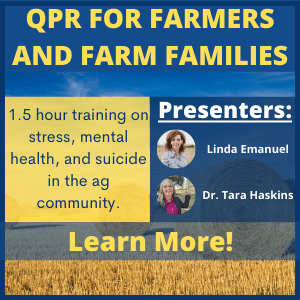Last updated on July 19th, 2024 at 02:56 pm
Reproductive Health Resources
Women have significant exposure to agricultural work and therefore related health and safety risks from farm exposures. Women who are pregnant or planning a pregnancy, especially those currently performing farm work, should be informed of the implications of exposure before, during, and after pregnancy, and assisted in making decisions that are appropriate for their individual work and home situations. Read about general reproductive hazards from MedlinePlus. However, there are hazards specific to agriculture.
Hazards
Risks to women who are pregnant or planning to be pregnant include:
Herbicides
Herbicides are used to kill undesirable plants or weeds.
Exposures: Mixing and applying herbicides and fungicides up to 2 years before attempting conception is associated with observed lower fertility.
Risk: Could lower rates of fertility.
Needlestick Injuries
Needlestick injuries are wounds caused by needles that accidentally puncture the skin.
Exposures: Livestock production hormones Oxytocin and Prostaglandin
Risk: May cause abortion in pregnant women.
Carbon Monoxide
Carbon monoxide is a colorless, odorless, tasteless gas produced by burning gasoline, wood, propane, charcoal, or other fuel.
Exposures: Livestock buildings and high pressure washers
Risk: High for women and elevated risk in unborn fetus including low birth weight and slowed mental development.
Zoonotic Diseases
Zoonotic diseases (also known as zoonoses) are caused by infections that spread between animals and people. Pregnant women have an altered immune system during pregnancy.
Exposures: Direct/indirect contact, vector-borne, foodborne
Risk: May cause abortion in pregnant women.
Nitrate Toxicity
Infants who are fed formula made with water high in nitrate concentrations (>10 mg/L) have the potential to be poisoned.
Risk: A congenital health disease known as Blue Baby Syndrome
PPE
Personal protective equipment can reduce the risk of agricultural hazards to women who are pregnant or planning a pregnancy. Appropriate PPE includes:
- Coveralls
- Eyewear
- Respiratory protection
- Footwear
Reproductive Health Resources
Articles
Fact Sheets
| ID | Title | Summary | Link |
|---|---|---|---|
| 8417 | Reproductive Health Exposures for Women in Agriculture | A guide designed to help women protect their reproductive health when working in agriculture. | |
| 8421 | Riesgos de la salud reproductiva femenina en la agricultura | A Spanish language guide designed to help women protect their reproductive health when working in agriculture. | |
| 12752 | Sea responsable con su salud | This Spanish language fact sheet is designed to highlight the unique risk factors for women working in agriculture. Practical solutions are offered to assist farm women in maintaining a healthy and productive farming future. | |
| 8423 | Take Charge of Your Health – Women Working in Agriculture | This fact sheet is designed to highlight the unique risk factors for women working in agriculture. Practical solutions are offered to assist farm women in maintaining a healthy and productive farming future. |
Webinars
| Webinar Title | Summary | Link |
|---|---|---|
| Hazard Communications Standards (December 7, 2021) | This Hazard Communication Standard training program is intended for female workers and managers in the agricultural industry. This includes dairy farms and small farms that hire at-risk populations. The major focus of the program is on the identification of and the safe usage of chemicals and pesticides, along with respiratory protection. | |
| Reducing the Risk of Adverse Pregnancy Outcomes and Perinatal Illness for Female Ag. Producers (December 16, 2020) | Pregnancy and fertility are often not considered when women assume farm tasks. Pesticide and other chemical exposures, zoonotic diseases and heavy lifting particularly during childbearing years, present challenges. | |
| What to Expect While Expecting- For Female Producers & Farmworkers in Ag (February 16, 2022) | Pregnancy and fertility are often not considered when women assume farm tasks. Pesticide and other chemical exposures, zoonotic diseases and heavy lifting particularly during childbearing years, present challenges. | |
| Zoonotic Disease and Pregnancy: A Deeper Dive | Zoonotic Diseases are transmitted between farm animals and humans and can pose additional risks to those who are pregnant. Farmers and farmworkers have higher levels of risk for contracting zoonotic diseases because of the frequency of their exposure to animals. Prevention is the best defense. Women working in agriculture should be aware of the following special considerations during pregnancy, which animals are common carriers of zoonotic disease, symptoms of the disease(s), prevention measures, and pregnancy risks. |
Page updated: August 2022

